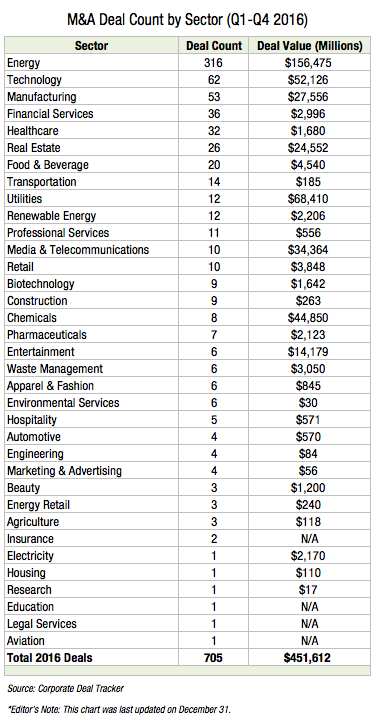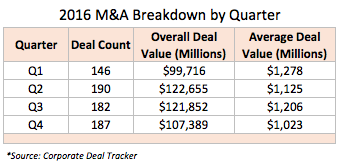© 2017 The Texas Lawbook.

By Natalie Posgate
(Jan. 27) – One year ago, times were not great for many Texas M&A lawyers – notably, those handling energy deals.
But now, those hard times appear to be out the door – or at the very least, on their way out. New data shows that a resurgence in energy deals, Texas’s most dominant sector for M&A, as well as a tremendous spike in deals from other sectors, drove a revival of M&A work for Texas-based lawyers. Lawyers who advised on some of those deals say the momentum is continuing into 2017.
Texas-based lawyers represented companies all over the world in 705 mergers, acquisitions, divestitures and joint ventures in 2016 – a 24 percent increase from the 565 such deals reported to The Texas Lawbook’s Corporate Deal Tracker in 2015.
Even more impressive from the 18 percent increase in energy-related deals was the uptick of transactions that Texas lawyers worked on outside the energy sector: food & beverage increased by 566 percent, while tech deals more than doubled.
Tech work by Texas lawyers during 2016 includes Microsoft’s $26 billion acquisition of LinkedIn, PetSmart’s purchase of the pet adoption site, AllPaws.com; and Hewlett Packard Enterprise’s $275 million acquisition of Silicon Graphics. On the food & beverage side, Texas law firms represented big names like Gores Holdings’ $725 million purchase of the Twinkies baker, Hostess Brands; Anheuser-Busch InBev’s purchase of Houston’s Karbach Brewing Co.; and Borden Dairy’s sale of Laguna Dairy to Grupo Lala.

Deals in the manufacturing, healthcare, financial services, media & telecommunications, biotech and consumer services sectors also increased from 2015 to 2016.

“The environment was very attractive for merger and acquisition activity last year,” said Mark Solomon, managing partner of Andrews Kurth Kenyon’s Dallas office who represented clients in the food & beverage, automotive, manufacturing, retail pharmacy and technology sectors last year. “On the buy side, economic optimism, availability of financing and the indigenous deal cycle for a variety of clients fueled a fair amount of activity. A number of sellers also perceived that the market was at its top or close to the top. I also had two deals that probably should’ve closed in 2015 that closed in 2016… My colleagues in Houston saw significant energy-related M&A activity.”
The fourth quarter of 2016 carried with it a guarded sense of optimism for the new year. Though the average deal value of $1.02 billion was lower than each of the previous three quarters, the sheer quantity of year-end deals was impressive. The 187 deals announced in Q4 2016 were 41 percent higher than the same quarter in 2015. And some Texas M&A lawyers said that busy vibe has continued to maintain itself as the first month of 2017 comes to a close.

“I think we saw a lot of more healthy deal activity toward the end of the year; 2017 is just continuing the trend we saw in the last three or four months of 2016,” said Anthony Speier, a partner in Kirkland & Ellis’s Houston office who specializes in energy deals. “Buyers are paying higher prices, while sellers are selling at slightly lower prices than two years ago. There’s a little bit more stability in the market.”

“I think it’s a little too soon to tell and there is still a lot of geopolitical uncertainty, both in the United States and abroad – particularly Europe, with French and German elections this year and the actual intricacies of Brexit to be dealt with,” said Alain Dermarkar, a partner in Jones Day’s Dallas office who represents U.S. and international companies in a variety of industries. “That said, if we do see regulatory and tax reform here in the United States, we may see that provide a tail wind to the economy generally and the M&A market in particular.”

Like ‘night and day’
Energy M&A lawyers say the deal flow they witnessed in 2016 versus 2015 was like “night and day,” as Speier put it.
When 2016 began, energy companies were still worried that oil production might remain too expensive to be profitable in the foreseeable future.
Drilling projects stood still as low oil prices lingered, at one point dropping below $27 per barrel, the lowest price since 2003. Disconnected buyers and sellers disagreed on the value of assets, preventing either side from negotiating deals. Instead of drafting up term sheets, M&A lawyers were continuing to advise their clients to correct their balance sheets, as they had in 2015.
“It was December of 2014 when things started to get really slow,” said Jeffrey Muñoz, a partner in Latham & Watkins’ Houston office. “And 2015 just continued that trend. I think everyone was somewhat looking around for work; there was not much of anything. Starting in September of last year, the floodgates just opened.”

Muñoz said this year is proving quite different so far.
“I think I have done more work in the first few weeks of January than I did in all of January and February of last year,” he said.
Like the year before, 2016 began very slowly. But by mid-year oil was flirting with $50 per barrel, and lawyers were ending a year-and-a-half slump in energy deal flow. Of the 705 deals reported to the Corporate Deal Tracker, nearly half (344) were energy-related – oil and gas, renewable energy and power industries. That was 18 percent more than 2015, which saw only saw 291 such deals.
“When you’ve got 18 months of pent up demand and when you finally open the floodgates, a lot of people are going to try and get deals off,” said Robert Rabalais, a partner in Simpson Thacher & Bartlett’s Houston office who specializes in representing banks on the lending aspect of energy M&A deals. “There’s going to be a boom for M&A lawyers and all other transactional disciplines, be they what I do or capital markets.”

The pent-up demand on the buyer’s side was especially prevalent with private equity firms, which still have not deployed all of the capital they raised over the last few years prior to the commodity price collapse in 2014.
“Private equity usually has delays in cycles,” said Mingda Zhao, a partner in V&E’s Houston office. “What they’re spending now is a lot of money they would have raised in 2013 or 2014.”
Lawyers heavily focused in oil & gas said they saw, in particular, a recovery in upstream E&P companies. Once prices improved, many E&P companies began drilling again and striking deals – especially in West Texas’s Permian Basin, one of the only areas in the U.S. that companies have been able to make money in despite the lower price environment.
Asked why the Permian is so economical to drill from, Speier compared the land to a “layer cake” in which each layer contains oil that is extractable. He said when oil is laid out this way, the drilling companies don’t have to “deploy as much capital” to get the oil out of the ground.
“You don’t have to drill a bunch of different wells – you can drill one well, with a bunch of laterals tapping into various layers in the same area,” he said. “You don’t need as big of an area [to drill] because you have so many layers on top of each other. Infrastructure costs are reduced as you can produce multiple formations from the same surface locations.”

Bryan Loocke, a partner in V&E’s Houston office, said 2016 deal flow was in part driven by “exits from some larger independents selling non-core assets to fund core assets,” particularly in the Permian. “Anadarko, Devon and others were doing a lot of divestitures of non-core areas,” he said.
Anadarko did just this two weeks ago when it announced its exit from the Eagle Ford Shale by selling all of its assets there to Blackstone Group and Sanchez Energy for $2.3 billion. The Woodlands-based company announced it would use the proceeds to focus its efforts on “higher-return” basins, including the Permian’s Delaware Basin.
Some lawyers had luck conducting deals this past year in other regions – even some regions that are still too expensive, given the current oil price environment.
Mike Bengtson, a partner in Baker Botts’ Austin office, was one of those lawyers.

Of the 10 deals he handled in 2016, Bengtson said eight were upstream and two were midstream. Of the upstream deals, some were for natural gas clients focused in the Marcellus and Utica shale areas.
“The sellers were typically somewhat distressed in that they were trying to deleverage; some sellers were selling non-core assets where they didn’t operate,” Bengtson said. “It was an opportunity for clients such as mine that have strong balance sheets to add to their positions in what they saw as a stabilization in commodity prices last year.”
If there was one trend that every energy M&A lawyer said they noticed this past year, it was the “dual track” approach that many private equity-backed portfolio companies took when deciding how to raise money. The process starts when the company files for an initial public offering via an S-1 form, while also hunting prospects to sell the company to an interested buyer.
“I think there are a lot of people who have exit strategies, and it is either sell or go public,” said Rabalais. “What you’ll see I think is a lot of people running dual tracks like Vantage did. They do an S-1 filing to go public, but use that as a marketing tool and if they can get the appropriate valuation, they’ll just sell.”
Vantage Energy, an Englewood, Colo.-based E&P company focused on the Barnett and Marcellus shales, was initially backed by Quantum Energy Partners, Riverstone Holdings and Lime Rock Partners. Vantage filed for an IPO in mid-September, only to sell itself to Canonsburg, Pa.-based Rice Energy two weeks later for $2.7 billion.
When companies took the “dual-track” approach last year, Loocke said “much to the chagrin of our capital markets partners,” the M&A lawyers won “for the most part” when portfolio companies opted instead to divest assets to private equity firms or sell majority stakes in their companies to them rather than go public. However, Loocke anticipates the tables to turn in 2017 since the capital markets have begun to open up.
“I think you’ll see [the dual-track transactions] more likely to go the IPO route,” he said.
Texas lawyers with global reach
While Mergermarket data recently published by The Texas Lawbook suggests that growth in deal count involving Texas-based companies remained flat, the Corporate Deal Tracker data reveals that Texas-based M&A lawyers logged more work because they gained or maintained clients outside the Texas and U.S. borders.
Thirteen of the top 20 largest 2016 deals reported to the database were transactions that did not involve Texas-based companies on either the buyer’s or seller’s side, while the remaining 35 percent involved at least one Texas-based company. In the fourth quarter alone, 38 percent of the 173 non-confidential deals that Texas firms reported did not involve Texas-based companies, and a good portion of those out-of-state companies were international.
“Texas lawyers are benefitting from the strong Texas economy, which continues to be dynamic and vibrant,” said Jones Day’s Dermarkar. “In addition to the state’s tremendous energy industry, Texas boasts robust technology, healthcare and manufacturing sectors, among others.
“We continue to see a lot of companies choosing to invest in the state – this includes companies that are choosing to relocate from another state, as well as foreign multinationals deciding to site their U.S. or North American headquarters in Texas,” he added. “This diversity and dynamism provides a great base of potential clients for Texas lawyers.”
Solomon, the Andrews Kurth Kenyon partner, said he’s unsure of what forces might be driving it, but the trend toward increased global businesses seems obvious.
“I don’t find it surprising that Texas lawyers and companies are doing an increasing amount of interstate and international work,” he said. “About 25 percent of my deals had a meaningful international component.”

Baker McKenzie partner Roger Bivans agrees. He said currently he has two deals involving Swedish companies looking to acquire business units of global companies with substantial U.S. operations. He said that kind of international work is a direct result of his firm’s cultural willingness to collaborate, even across global offices on international deals.
“When you have an acquisition that involves multiple jurisdictions, we’re the natural choice for multinational companies,” Bivans said.
Editor’s Note: The Corporate Deal Tracker is sponsored by Weil, Gotshal & Manges. The content in CDT articles are completely independent and wholly controlled by The Texas Lawbook.

© 2017 The Texas Lawbook. Content of The Texas Lawbook is controlled and protected by specific licensing agreements with our subscribers and under federal copyright laws. Any distribution of this content without the consent of The Texas Lawbook is prohibited.
If you see any inaccuracy in any article in The Texas Lawbook, please contact us. Our goal is content that is 100% true and accurate. Thank you.
